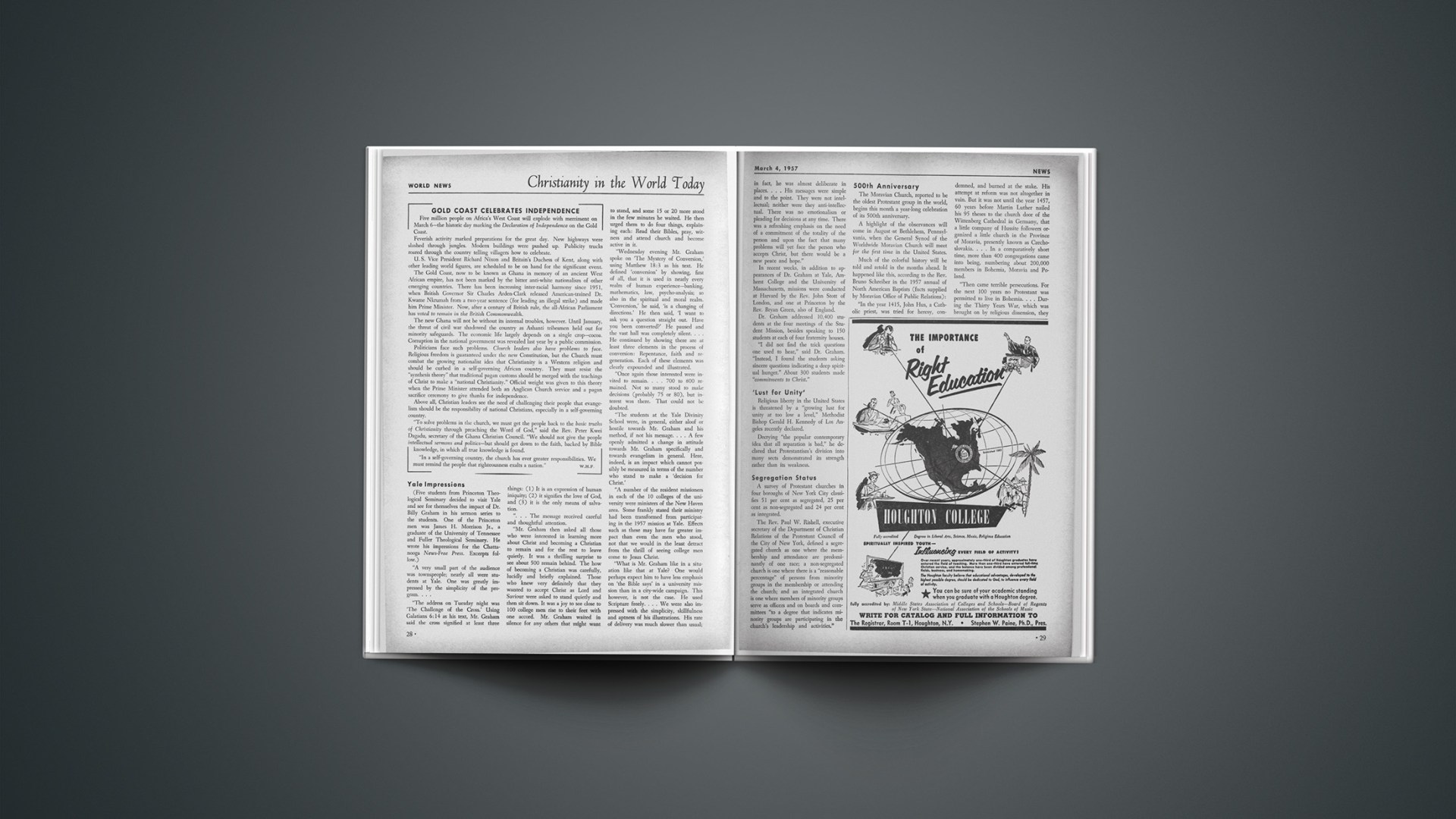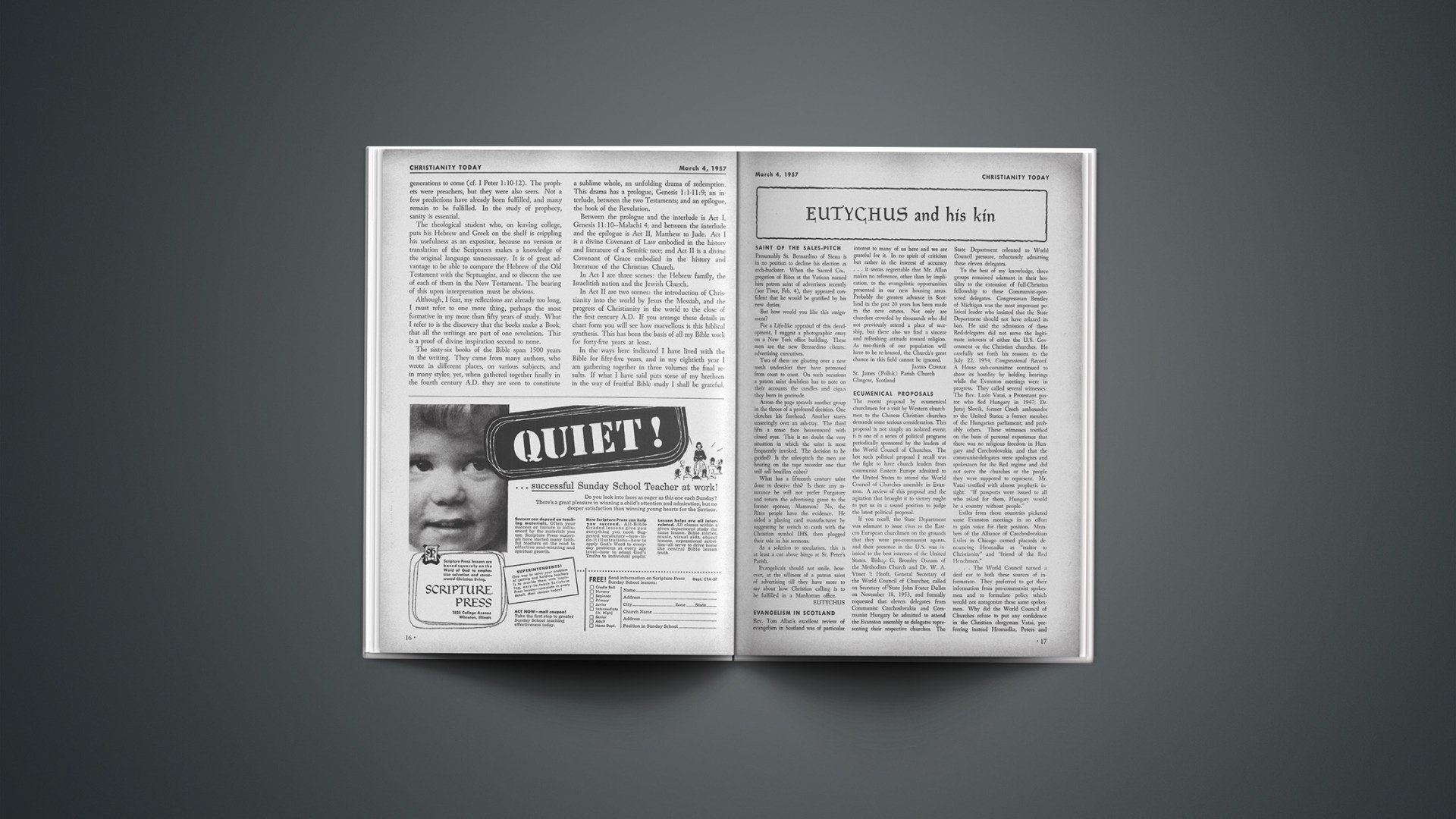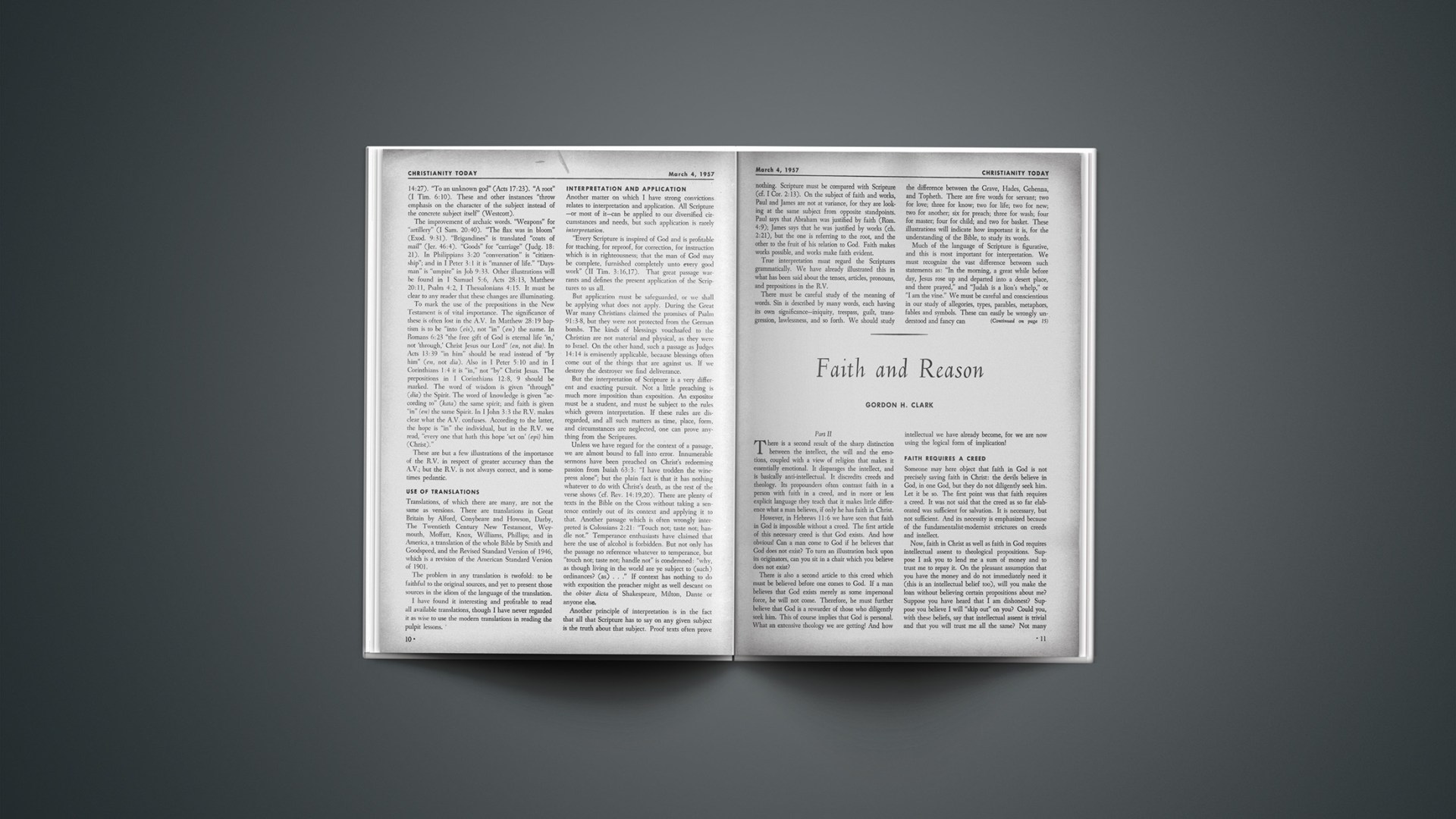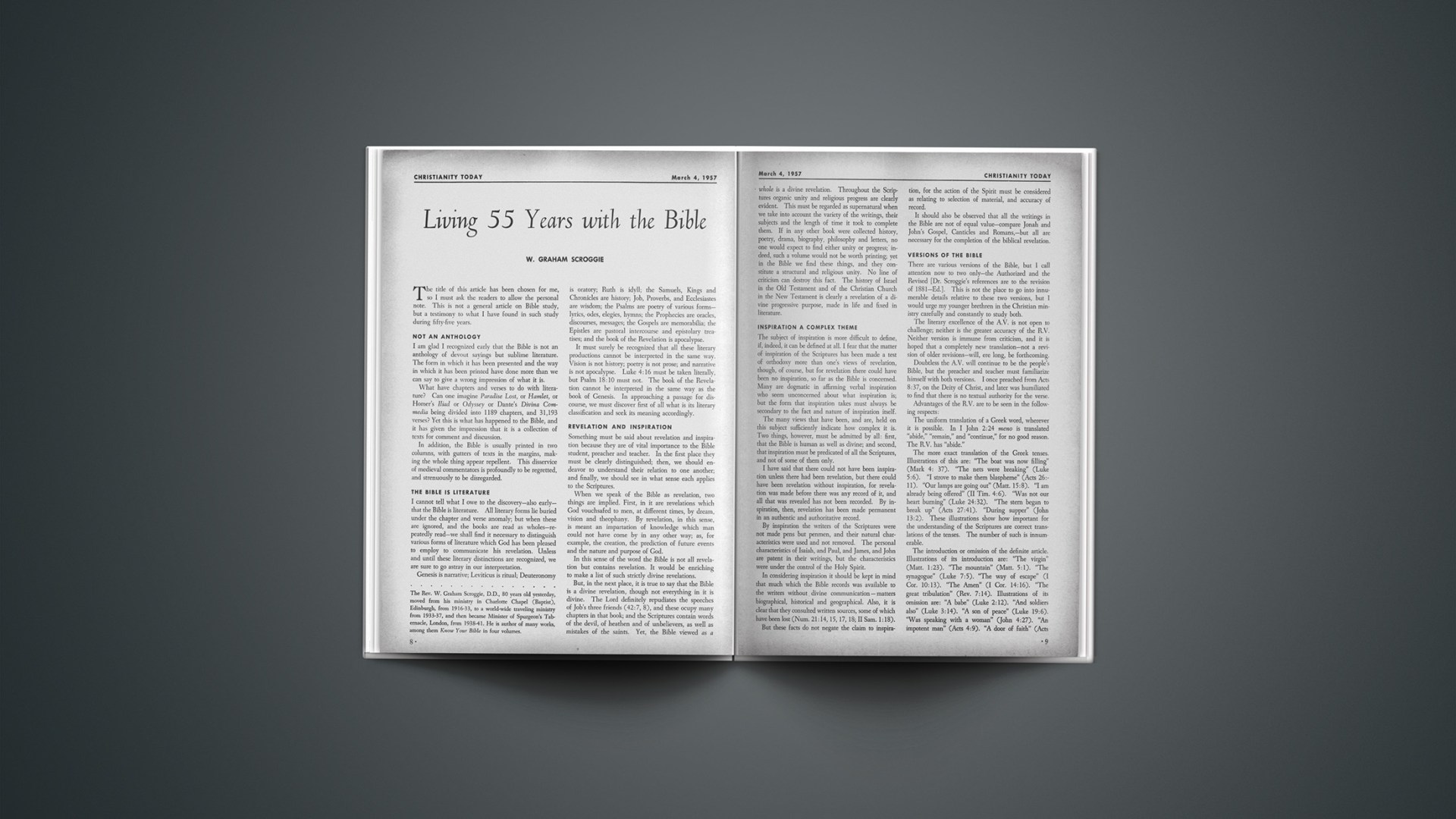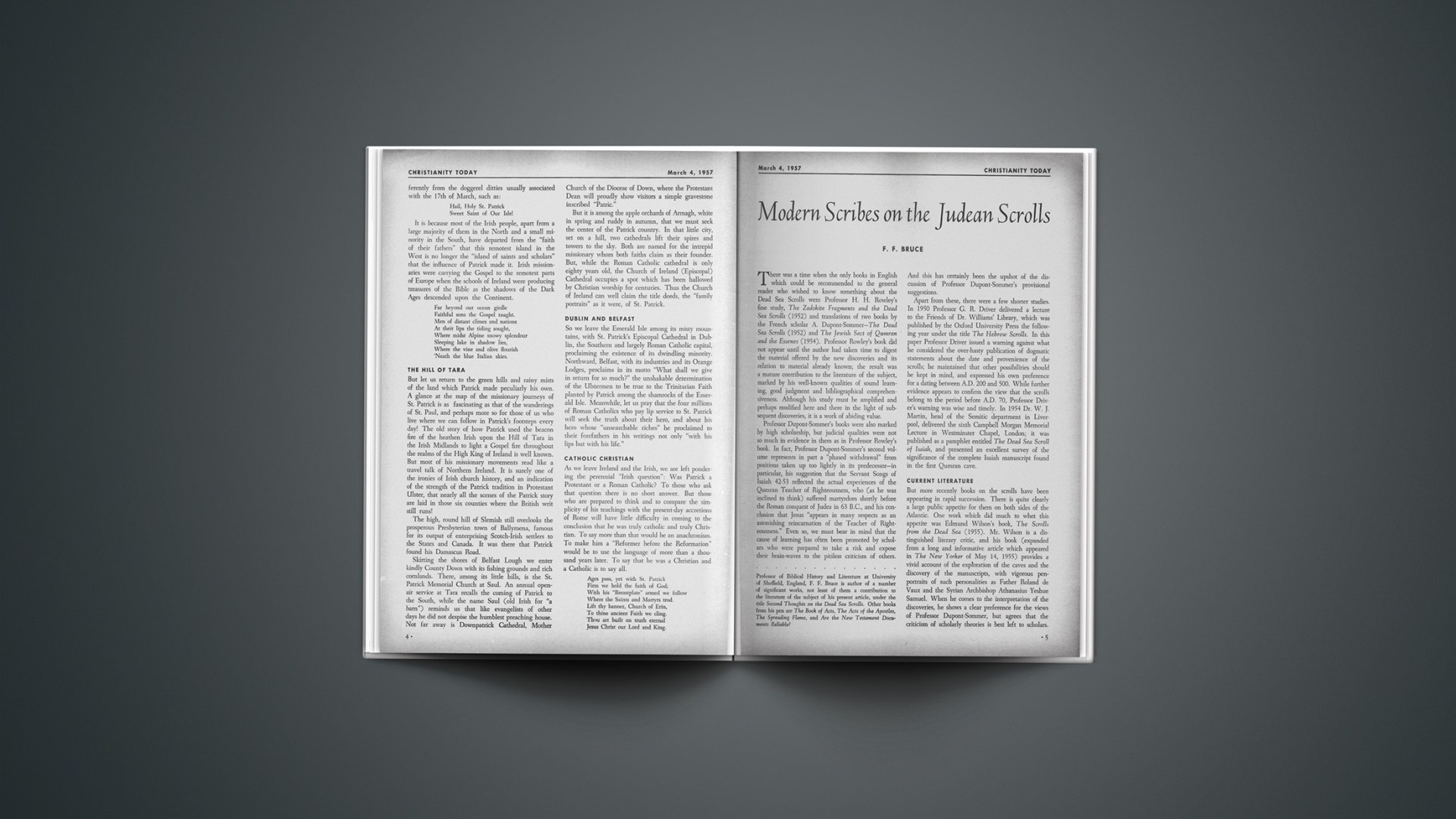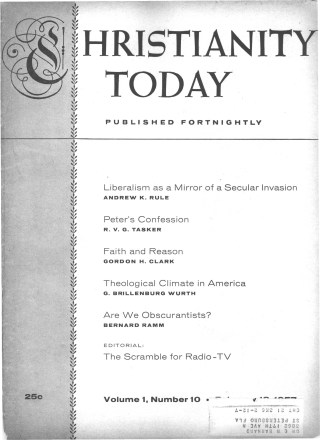Christianity in the World Today
Five million people on Africa’s West Coast will explode with merriment on March 6—the historic day marking the Declaration of Independence on the Gold Coast.
Feverish activity marked preparations for the great day. New highways were slashed through jungles. Modern buildings were pushed up. Publicity trucks roared through the country telling villagers how to celebrate.
U. S. Vice President Richard Nixon and Britain’s Duchess of Kent, along with other leading world figures, are scheduled to be on hand for the significant event.
The Gold Coast, now to be known as Ghana in memory of an ancient West African empire, has not been marked by the bitter anti-white nationalism of other emerging countries. There has been increasing inter-racial harmony since 1951, when British Governor Sir Charles Arden-Clark released American-trained Dr. Kwame Nkrumah from a two-year sentence (for leading an illegal strike) and made him Prime Minister. Now, after a century of British rule, the all-African Parliament has voted to remain in the British Commonwealth.
The new Ghana will not be without its internal troubles, however. Until January, the threat of civil war shadowed the country as Ashanti tribesmen held out for minority safeguards. The economic life largely depends on a single crop—cocoa. Corruption in the national government was revealed last year by a public commission.
Politicians face such problems. Church leaders also have problems to face. Religious freedom is guaranteed under the new Constitution, but the Church must combat the growing nationalist idea that Christianity is a Western religion and should be curbed in a self-governing African country. They must resist the “synthesis theory” that traditional pagan customs should be merged with the teachings of Christ to make a “national Christianity.” Official weight was given to this theory when the Prime Minister attended both an Anglican Church service and a pagan sacrifice ceremony to give thanks for independence.
Above all, Christian leaders see the need of challenging their people that evangelism should be the responsibility of national Christians, especially in a self-governing country.
“To solve problems in the church, we must get the people back to the basic truths of Christianity through preaching the Word of God,” said the Rev. Peter Kwei Dagadu, secretary of the Ghana Christian Council. “We should not give the people intellectual sermons and politics—but should get down to the faith, backed by Bible knowledge, in which all true knowledge is found.
“In a self-governing country, the church has ever greater responsibilities. We must remind the people that righteousness exalts a nation.”
—W.H.F.
Yale Impressions
(Five students from Princeton Theological Seminary decided to visit Yale and see for themselves the impact of Dr. Billy Graham in his sermon series to the students. One of the Princeton men was James H. Morrison Jr., a graduate of the University of Tennessee and Fuller Theological Seminary. He wrote his impressions for the Chattanooga News-Free Press. Excerpts follow.)
“A very small part of the audience was townspeople; nearly all were students at Yale. One was greatly impressed by the simplicity of the program.…
“The address on Tuesday night was ‘The Challenge of the Cross.’ Using Galatians 6:14 as his text, Mr. Graham said the cross signified at least three things: (1) It is an expression of human iniquity; (2) it signifies the love of God, and (3) it is the only means of salvation.
“… The message received careful and thoughtful attention.
“Mr. Graham then asked all those who were interested in learning more about Christ and becoming a Christian to remain and for the rest to leave quietly. It was a thrilling surprise to see about 500 remain behind. The how of becoming a Christian was carefully, lucidly and briefly explained. Those who knew very definitely that they wanted to accept Christ as Lord and Saviour were asked to stand quietly and then sit down. It was a joy to see close to 100 college men rise to their feet with one accord. Mr. Graham waited in silence for any others that might want to stand, and some 15 or 20 more stood in the few minutes he waited. He then urged them to do four things, explaining each: Read their Bibles, pray, witness and attend church and become active in it.
“Wednesday evening Mr. Graham spoke on ‘The Mystery of Conversion,’ using Matthew 18:3 as his text. He defined ‘conversion’ by showing, first of all, that it is used in nearly every realm of human experience—banking, mathematics, law, psycho-analysis; so also in the spiritual and moral realm. ‘Conversion,’ he said, ‘is a changing of directions.’ He then said, ‘I want to ask you a question straight out. Have you been converted?’ He paused and the vast hall was completely silent.… He continued by showing there are at least three elements in the process of conversion: Repentance, faith and regeneration. Each of these elements was clearly expounded and illustrated.
“Once again those interested were invited to remain.… 700 to 800 remained. Not so many stood to make decisions (probably 75 or 80), but interest was there. That could not be doubted.
“The students at the Yale Divinity School were, in general, either aloof or hostile towards Mr. Graham and his method, if not his message.… A few openly admitted a change in attitude towards Mr. Graham specifically and towards evangelism in general. Here, indeed, is an impact which cannot possibly be measured in terms of the number who stand to make a ‘decision for Christ.’
“A number of the resident missioners in each of the 10 colleges of the university were ministers of the New Haven area. Some frankly stated their ministry had been transformed from participating in the 1957 mission at Yale. Effects such as these may have far greater impact than even the men who stood, not that we would in the least detract from the thrill of seeing college men come to Jesus Christ.
“What is Mr. Graham like in a situation like that at Yale? One would perhaps expect him to have less emphasis on ‘the Bible says’ in a university mission than in a city-wide campaign. This however, is not the case. He used Scripture freely.… We were also impressed with the simplicity, skillfulness and aptness of his illustrations. His rate of delivery was much slower than usual; in fact, he was almost deliberate in places.… His messages were simple and to the point. They were not intellectual; neither were they anti-intellectual. There was no emotionalism or pleading for decisions at any time. There was a refreshing emphasis on the need of a commitment of the totality of the person and upon the fact that many problems will yet face the person who accepts Christ, but there would be a new peace and hope.”
In recent weeks, in addition to appearances of Dr. Graham at Yale, Amherst College and the University of Massachusetts, missions were conducted at Harvard by the Rev. John Stott of London, and one at Princeton by the Rev. Bryan Green, also of England.
Dr. Graham addressed 10,400 students at the four meetings of the Student Mission, besides speaking to 150 students at each of four fraternity houses.
“I did not find the trick questions one used to hear,” said Dr. Graham. “Instead, I found the students asking sincere questions indicating a deep spiritual hunger.” About 300 students made “commitments to Christ.”
‘Lust For Unity’
Religious liberty in the United States is threatened by a “growing lust for unity at too low a level,” Methodist Bishop Gerald H. Kennedy of Los Angeles recently declared.
Decrying “the popular contemporary idea that all separation is bad,” he declared that Protestantism’s division into many sects demonstrated its strength rather than its weakness.
Segregation Status
A survey of Protestant churches in four boroughs of New York City classifies 51 per cent as segregated, 25 per cent as non-segregated and 24 per cent as integrated.
The Rev. Paul W. Rishell, executive secretary of the Department of Christian Relations of the Protestant Council of the City of New York, defined a segregated church as one where the membership and attendance are predominantly of one race; a non-segregated church is one where there is a “reasonable percentage” of persons from minority groups in the membership or attending the church; and an integrated church is one where members of minority groups serve as officers and on boards and committees “to a degree that indicates minority groups are participating in the church’s leadership and activities.”
500Th Anniversary
The Moravian Church, reported to be the oldest Protestant group in the world, begins this month a year-long celebration of its 500th anniversary.
A highlight of the observances will come in August at Bethlehem, Pennsylvania, when the General Synod of the Worldwide Moravian Church will meet for the first time in the United States.
Much of the colorful history will be told and retold in the months ahead. It happened like this, according to the Rev. Bruno Schreiber in the 1957 annual of North American Baptists (facts supplied by Moravian Office of Public Relations):
“In the year 1415, John Hus, a Catholic priest, was tried for heresy, condemned, and burned at the stake. His attempt at reform was not altogether in vain. But it was not until the year 1457, 60 years before Martin Luther nailed his 95 theses to the church door of the Wittenberg Cathedral in Germany, that a little company of Hussite followers organized a little church in the Province of Moravia, presently known as Czechoslovakia.… In a comparatively short time, more than 400 congregations came into being, numbering about 200,000 members in Bohemia, Moravia and Poland.
“Then came terrible persecutions. For the next 100 years no Protestant was permitted to live in Bohemia.… During the Thirty Years War, which was brought on by religious dissension, they were almost wiped out.
“… Their hope and prayer were that the ‘hidden seed’ would survive. For the next 150 years they were a bewildered and confused people. Without consecutive leadership or adequate instruction, they held on to one great central conviction—the reality of their experience with God.
“In 1722 a group fled into Saxony, where shelter was granted them by Count Nicholas Ludwig Zinzendorf, a generous and devout young nobleman … their ancient unity was again restored.
“So great and earnest was their missionary zeal that, although the total Moravian community in all the world consisted of no more than 600 souls, their missionaries were already at work in 13 different countries … even today their record for missionary endeavor is without parallel in the history of Protestantism. Whereas the congregations of the home church number no more than 65,000 members, the convert members on their mission fields total over 200,000.
“If there was a creed expressed in the Moravian Church, it was simply, ‘Christ, and Him Crucified.’
“In 1736 Count Zinzendorf was banished from Saxony because of the disturbance created by his evangelical zeal. After a number of years of evangelical labors on the continent, in England and in the West Indies, he made his way to Pennsylvania in the New World.…
“Freedom of worship and the opportunity of finding a new home led other refugees to follow Zinzendorf … George Whitefield, who purchased a tract of 5,000 acres in eastern Pennsylvania, offered 500 acres to the new community … On Christmas Eve, 1741, the new community was named Bethlehem.…
“A few years later the first Moravian house of worship was built. To this chapel came Martha Washington, Maruis Lafayette, Benjamin Franklin, Count Pulaski and other prominent figures of the Colonial Days. It is still used for special occasions.…
“The Moravians were also pioneers in education. John Amos Comenius, a bishop in the church, is commonly referred to as ‘the father of education’.… As one of the outstanding educators in world history, he was offered the presidency of Harvard College in 1642.
“… It was during a dreadful storm at sea that John Wesley’s life was first influenced by the Moravians. Many of the passengers had given up all hope of ever reaching land alive. While the small vessel pitched and tossed dangerously upon the stormy sea, the frightened Wesley stared at a little company of 26 Moravians on the same ship gathered around their bishop, David Nitschmann, quietly engaged in singing and praying as if all unaware of the terrible tempest.
“After anxiously inquiring about the secret of such courage and peace, he heard for the first time about a religious faith that could take the spirit of fear out of a man’s heart. The strangest fact about his sea voyage was that he was on his way to preach to the American Indians while he himself was desperately in need of salvation. It is no wonder that his mission proved to be a dismal failure.
“It was not until he returned to London and came into contact with another Moravian preacher, Peter Boehler, that John Wesley again became anxious about his spiritual condition. He began to probe for the secret of which he had become aware on board the little ship.…
Medical Humbug
“Doctor Advises Beer for Princess,” read headlines across the nation.
Grace Kelly Rainier’s physician had recommended a glass of beer at each meal because “it’s good for convalescing mothers and she loves it anyway.”
Ten newspaper ads carried announcements from Pabst about a foamy gift, Monaco bound. Budweiser jumped on the beer wagon for all it was worth.
Six pediatricians in the Washington, D. C. Medical Society debunked special benefits from beer as new mothers rushed for the grocery shelves.
Milk is better, agreed the doctors.
“About three weeks later in a private meeting in which some Moravians were present, John Wesley experienced what he later called ‘a strange warming of the heart.’ ”
Cut In Clergy Fares
The second commercial airline to file a tariff schedule with the Civil Aeronautics Board offering reduced fares to clergyman is Cordova Airlines of Anchorage, Alaska.
Cordova, which connects a number of cities in Alaska by daily air service, proposes cuts of from 47 to 52 per cent.
Bonanza Airlines of Las Vegas, Nevada, recently put into effect a 50 per cent reduction for clergy, with CAB approval.
Urgent Need
Bishop Richard C. Raines of Indianapolis, in an address to Methodist leaders, listed the following “urgent” needs:
Each year, 1,200 pastors for replacement, 500 for new churches, 275 for chaplaincies, 450 for multiple ministry associates, 375 for circuit churches, 350 missionaries, 280 directors of religious education, 255 campus religious workers and 4,000 student nurses.
Nation’S Oldest Church
“Old St. Luke’s,” the oldest church in America, will celebrate its 325th birthday anniversary on May 15.
Visitors from many points of the world will visit the small rural church, four miles from the town of Smithfield, Virginia. The occasion will be part of the Jamestown Settlement Festival, commemorating the 350th birthday of this notable event.
The Archbishop of Canterbury, Dr. Geoffrey Fisher, is expected to visit the United States to take part in the celebration.
Now a national shrine, St. Luke’s was in a state of collapse as late as 1954, but has been restored to its rightful place of honor by an alarmed Restoration Committee.
President Dwight Eisenhower, taking note of the effort, sent the following letter to Henry Mason Day, committee president:
“All those who have helped toward the restoration of historic St. Luke’s, known to America as ‘The Nation’s Oldest Church,’ have preserved for generations to come a great symbol of our spiritual heritage.
“This monument to the founders of our country is in truth a national shrine. Visitors there, inescapably, will be reminded of the deep religious convictions of the first settlers, their faith in God and their faith in themselves as children of God. St. Luke’s, more than a time-hallowed relic of the past, will be an enduring witness to the spirit that animated them, for within its walls our forefathers gained new courage, firm perseverance, abiding strength to make of the wilderness a home for themselves and all who followed them.
“My congratulations go to you and to all associated with you in the campaign to restore St. Luke’s, and my warm thanks to all who helped with their contributions.”
In writing of the church’s great history, James Grote Van Derpool, president of the Historical Architects of America and chairman of the Restoration Committee, said:
“Not only is it the oldest extant church of English foundation in the United States, but it is the only original Gothic church remaining within the confines of our great country. The traditional and widely accepted date of its construction is 1632. Even so, it may well be the second church on this venerated site, replacing a temporary chapel which was served by the Reverend William Bennett, who was minister of Warrosquyoake Parish in 1622–23.
“The present church follows in spirit of design the delightful small parish churches of Essex, England, from whence came in 1619 various of the earliest settlers of this region, which was orginally named for the Warrosquyoake tribe of Indians inhabiting it at the time of the arrival of the first English settlers in Virginia in 1607. The name of the region was changed about 1637 to Isle of Wight, the name it still bears as a Virginia county.
“Set in the rolling acres of its venerable churchyard, Old St. Luke’s stands both as a symbol of the living faith of our forefathers and the devotion of their descendants. Fire and strife of war have spared it, while other churches of comparable dating have long since been lost to us. However, the hands of time and zealous restorers have not left it unscathed. The wonderful old timber trusses were renewed and then concealed in the eighteenth century by plaster vault. The floor level was changed on two successive occasions as the earth about the church rose to higher levels with the passing of the years. A series of minor alterations and repairs necessary to the maintenance of any building in the course of its life, accumulated.
“A severe storm in 1887 inflicted such heavy damage to the church that an extensive repair program was initiated, without which the church would doubtless have passed into complete ruin. Its active function had been largely transferred to the town of Smithfield, when Christ Church was built there between 1832–36. Since that time, the use of St. Luke’s has been sporadic and since 1926 only occasional services have been held there.
“By 1951, the walls had begun to bulge ominously, and in 1954 the foundations of the church were discovered to be in such dangerous condition that collapse of the whole structure appeared imminent.
“Alarm spread througout Newport Parish, throughout Virginia, and so on through the nation itself … Could a generation which had seen the construction of engineering triumphs like the Panama Canal, vast harbor installations, powerful dams, great skyscrapers and a whole sequence of incredible scientific feats leading up to nuclear fission, stand quietly by and allow the destruction of one of the most exceptional monuments of our civilization?
Department Of Peace
Legislation to create a Department of Peace, designed to carry out the prayers voiced by President Eisenhower, has been introduced in Congress by Rep. Harold C. Ostertag (R-N.Y.).
The bill, H.R. 4298, calls for a National Peace College as a spiritually strategic counterpart of the Army War College. It also calls for consolidation, under a Secretary of Peace, of International Cooperation Administration (ICA), the U. S. Educational Exchange Program and the U. S. Information Agency.
Rep. Ostertag, in a statement for CHRISTIANITY TODAY, declared:
“You will recall that Emerson said of battleships … ‘By an idea, the battleships were created; by an idea, they will disappear.’ Today we are in peril of annihilating ourselves for lack of an idea to make them (the battleships) disappear. A Department of Peace may not be the priceless idea, but it might well be the seedbed for it.
“At this time, when the motives of the United States are widely misunderstood and are being misinterpreted by the communists for their own ulterior ends, it is doubly appropriate that we create by statute a Department solely to wage peace.”
“Almost as if it were a part of some great design, a loyal Virginian, Henry Mason Day, descendant of one of the original settlers of the region, a man whose business judgment had been directed in furthering great business enterprises, both in Europe and America, returned from New York to visit the home of his forebears.”
Day was inspired to spearhead a restoration movement and his feeling that it should be a national project struck a sympathetic response.
The task proved successful.
Thousands will pause on the scene May 15 and thank God for the great spiritual heritage.
Musical Clue
Thieves took $3 worth of candy and 2,000 copies of sheet music from the car of Albert H. Neinz, chaplain for the Columbus, Ohio, police department.
The sheet music was titled, “Not Mine, But Thine.”
‘Beulah Land’ Rock
The National Association of Music Teachers heard a suggestion recently that such hyms as “Beulah Land” and “There’s Honey in the Rock” should be blacklisted for church use because of their rock and roll effect.
Dr. William C. Rice, fine arts division chairman, Baker University, Baldwin, Kansas, made the suggestion. He commended such hymns as “Holy, Holy, Holy” and “Faith of Our Fathers.”
Memorable Things
Many important things were said and done at the recent annual conference of International Christian Leadership in Washington, D. C. Here are some that impressed the memory:
A prayer, by Richard C. Halverson, associate executive director of ICL—
“Our Father in Heaven, we gather in this warm, comfortable fellowship while there are millions who know neither warmth nor comfort nor dare to gather in thy name. We meet here with respect and affection for our national leaders, to pray for them, while there are millions who live in fear and hatred of their rulers. We enjoy these benefits of food and drink while there are millions who never know the luxury of a full stomach. We live in a dispossessed refugee world, yet our prosperity has so insulated us against the world’s misery that we are barely aware of it.
“Deliver us from the complacency that takes these blessings for granted. Cleanse us of the sins of pride and self-seeking. Grant, O God, that this breakfast may be a testimony to the world that we take Jesus Christ seriously, that America’s leaders accept their role in human affairs to be ordained of God, and so receive our gratitude and dedication here this morning for thy glory, in the name of thy son and our savior, Jesus Christ the Lord. Amen.”
A challenge, by Dr. Billy Graham—
“This is the golden hour for the church. The present moment has no parallel in the history of Christianity. Scientists, students, sociologists and politicians are beaten and baffled by life’s problems and are saying to religious leaders: ‘Come and help us.’ ”
A warning, by Dr. Carl F. H. Henry, editor ofCHRISTIANITY TODAY, against a “secular surge” in educational institutions—“… the effectiveness of the faith nurtured in our homes and churches is constantly threatened and depressed from above. Advanced and professional instruction instead of nurturing faith, impoverishes it, and the highest strategic grades of our vocational training have been placed largely in the hands of an intelligentsia that is in revolt against our Christian heritage.”
A word of support, by Vice President Richard M. Nixon, for the New York City Crusade of Dr. Billy Graham—“This is one of the most courageous spiritual ventures in our generation.”
(Boyd H. Leedom, chairman of the National Labor Relations Board, was elected president of ICL. He succeeds Governor Price Daniel of Texas. Senator Frank Carlson [R-Kans.] was reelected president of the International Council for Christian Leadership, the world body with which the American group is affiliated. ICL was founded in 1935 at Seattle, Washington, by Abraham Vereide, who still serves as executive director. More than 230 groups meet regularly throughout the world.)
Clergy Ailments
Seven ailments most common to ministers are listed by the Rev. J. A. Davidson in the Observer, official United Church of Canada paper:
► “Shrader’s Neurasthenia—a listlessness and apathy brought on by prolonged meditation over a Life Magazine article entitled ‘Why Ministers Are Breaking Down.’
► “The Schlegenheimer Compulsion-drives victims to speak and write gobblegook. Some victims also suffer from the strange delusion that to be unintelligible in the pulpit is to maintain the prestige of the ministry.
► “Parson’s Red Face—the result of wearing a clerical collar half-a-size too small and not of secret tippling, as some cynics suggest.
► The Dick-Gestetner Syndrome—symptoms include ink-poisoning, hands blistered by constant cranking, twitching of the eyes caused by watching hundreds of sheets of white paper flit by … mucilage-induced toxic inflammation of the mouth and stamp-licker’s tongue.
► “Theologian’s Strabismus (or squint)—comes from too much reading of italicized rubrics in old prayer books.
► “Mark Tapley Neurosis—a strange state of persistent and sometimes violent jolliness.
► “Saturday Night Thumb—the result of spending every Saturday night thumbing through back numbers of Pulpit Digest … the nothing-to-preach jitters.”
New Moody Series
A new series of children’s Bible adventure films for television, produced by the Moody Institute of Science, are scheduled to be shown by stations this year.
Favorable public reaction was reported after a first viewing on 66 stations across the country.
Heart Patients
Comforting visits by clergymen are beneficial to heart patients.
That was the conclusion of heart specialists, psychiatrists and clergymen at a seminar sponsored by the Chicago Heart Association.
The symposium, first of its kind in the Chicago area, was attended by 125 ministers and rabbis.
“We ministers have long wondered whether we should step in immediately when a member of our congregation suffers a heart attack,” said Dr. Granger Westberg, professor of religion and health at the University of Chicago. “We have considered whether our presence at such a time would be the cause of additional shock. Doctors tell us ‘no.’ In fact, the minister becomes the most important person in the patient’s life at that particular moment.”
“The comforting visit of a clergyman is helpful,” said Dr. George V. Le Roy, associate dean of the University of Chicago’s division of biological sciences.
Staggering Title
The nation’s capital should change its name to Washington, D. T., a Methodist minister suggests, because the city has “the highest rate of alcoholism in the world.”
In a speech at the annual meeting of the Methodist Board of Temperance, the Rev. Howard J. Clinebell Jr., Great Neck, N. Y., said Washington’s 49,450 alcoholics, averaging 7.8 per cent of every 100,000 male adults, is well ahead of the national rate of 4,390 alcoholics for every 100,000 men.
Dr. Clinebell said that of the 12 countries “whose rates of alcoholism have been estimated with some accuracy, the United States is so far out in front that she has lapped the field.” France is the nearest contender, he said, with a rate of 2,850 alcoholics per 100,000.
“Since our country leads the world in alcoholism and Washington leads the country, it seems to me that the city has a clear claim to the title of ‘alcoholic capital of the world,’ ” he said.
‘Laddy’S’ Hunch
“Laddy” McKillop, 10, has recovered a prized possession because of a “hunch.”
It had been feared that his Bible had been consumed in flames that destroyed his parents’ home in South Lancaster, Mass. The Bible was cherished as a Christmas gift from his pastor.
Days after the fire, the boy developed a conviction that the Bible had escaped destruction. Largely to humor his son, the father drove him to their former home. Among the charred timbers and other debris they found the Bible beneath a collapsed chair. Its contents and cover were unharmed by fire or water.
“Laddy” wants to be a minister some day.
“They don’t make much money,” he said, “but they do an awful lot of good.”
Worth Quoting
“Nothing short of a leadership led by God is adequate for the present crisis.”—Abraham Vereide, executive director, International Christian Leadership.
“We have the best and most modernly equipped army in the world. I pray each night that it will never be used, and I tell you that all of us had better pray.…”—Secretary of the Army Brucker.
Far East
5,422 Decisions
The largest evangelistic crusade ever held in the Philippines, with 5,422 decisions for Christ from nightly crowds of 6,500 and a closing rally of 15,000, has brought new hope among evangelicals in the predominantly-Catholic country.
Dr. Bob Pierce, president of World Vision, was the speaker for the three-week crusade. The choir numbered 600.
An off-season tropical thunderstorm broke over the meeting site prior to one service. On his arrival, Dr. Pierce found 3,000 people sitting in the rain, waiting for the meeting to begin. A total of 125 responded to the invitation that evening.
Cooperation for the crusade was a splendid example of spiritual unity among Protestant forces at work in the Philippines. The only group which openly opposed the meetings was the Association of Baptists for World Evangelism, with an expressed view that “God could not bless” a crusade when such as the Philippine Independent Church and other denominational groups were identified on the platform and on the sponsoring National Evangelistic Strategy Committee. (An identical point has stirred a controversy in connection with Billy Graham’s coming New York campaign.)
New Slant In Asia
The religious awakening in the United States is having a “profound effect” on non-Christians in Asia, according to Dr. E. Stanley Jones, noted 73-year-old Methodist missionary and evangelist.
“Many of the intellectual leaders of Asia have scoffed at religion,” he said. “They have felt all that is necessary for their people’s well-being is to raise their standard of living.
“Yet here they see the richest and most prosperous country in the world declaring openly that material possessions are not enough to give happiness and satisfaction in life.
“This is impressing Asians.”
Kermit Johnson, Orient Crusades missionary, is directing the follow-up work. Four classes, held immediately after the end of the meetings, were attended by 900. An estimated 65 Manila churches are now engaged in a systematic visitation program.
Twenty-eight per cent of the decisions were non-Protestant. President Magsaysay invited Dr. Pierce and his team to Malacanang Palace. Before leaving, the evangelist led in a prayer. The President later remarked to a friend what a great inspiration it had been.
Ambush In Philippines
It was the custom of Philip Watts, Christian lumberman from America, to leave his home in Zamboanga each Sunday night, travel by ferry and trail to his camp, work until Thursday and then return home.
The homecoming was always a joy, with a good wife and five wonderful children to greet him. On the weekends, he advised young people in church work and taught Sunday School. As a soldier in the Philippines during the war, he had determined to come back and help the people. He aided in establishing a church at Davao City.
On a Sunday evening in late January, Watts left for the lumber camp, accompanied by a friend, the Rev. Raymond Clemmer, Christian and Missionary Alliance missionary, and a Mr. Ybanez, the company paymaster. They arrived at Ipil at 4 a.m. after traveling on the little ferry for six hours. A jeep was waiting to take them over the rough trails cut through the jungles for lumber operations. About three kilometers inland, as they were making a turn, a burst of gunfire shattered the quietness. Watts shifted into low, for maximum speed in going up a hill, and stepped on the gas. The firing increased. Watts turned to Mr. Clemmer and said, “I’ve been hit.” A few seconds later he was dead.
The missionary grabbed the wheel and tried to get a foot on the gas pedal. With the body of his dead friend in the way, this didn’t work and he had to feed the gas by hand. One tire was flat and the jeep weaved wildly from side to side, but the camp was reached. Mr. Ybanez had a payroll of 9,000 pesos with him.
Police said later, after an investigation, that the ambushers had pursued for about 90 meters and intended to follow their custom of cutting victims into pieces. The missionary was creased on the hip by a bullet.
Despite the injury, Mr. Clemmer conducted a funeral similar to those in America, but without a pretty parlor and polite director.
Mrs. Watts and the children no longer look forward to the joyful homecomings on Thursday. Said the oldest girl, “It’s hard to take, but his grace is sufficient.”

